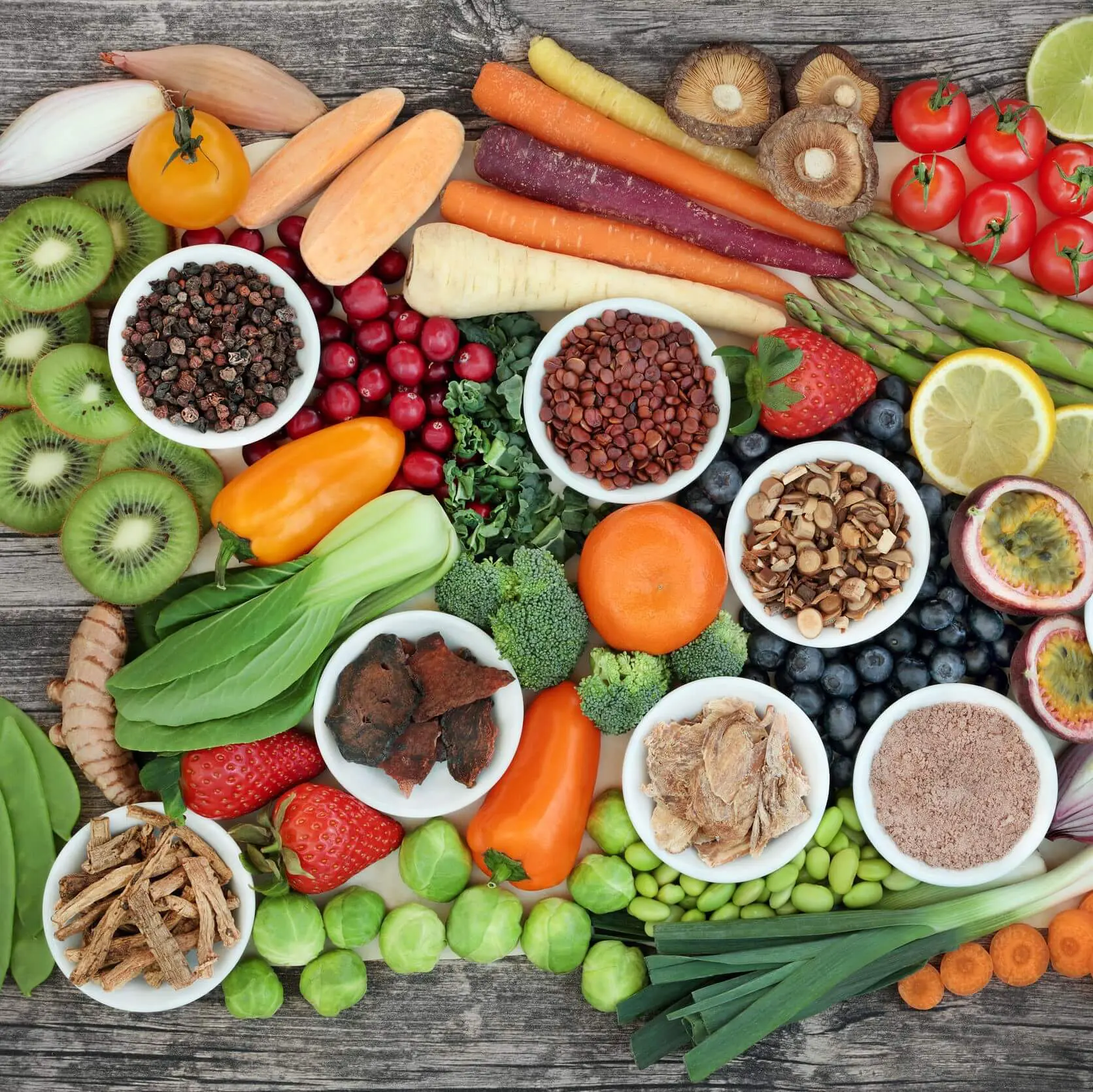
Vitamin D & Cancer Risk: New Insights from Top Researchers (Part 1)
Good evidence supports the potential for vitamin D to play a role in reducing cancer risk. However, optimal levels remain unclear, since some studies raise concern that body levels of vitamin D that are too high could pose risk.

Does vitamin D help lower cancer risk? If so, how much is best? (Image courtesy of NCI)
Vitamin D’s relationship to cancer was a major session at the latest research conference sponsored by the American Institute for Cancer Research (AICR), and new studies are underway to provide clearer answers. Here are insights from top researchers in the field to help us as we try to figure out what we should do while we wait for those answers.
Could vitamin D really lower cancer risk?
Studies of cell cultures show several ways that activated vitamin D could suppress cancer development through its impact on our genes. In these lab studies, vitamin D can help control cell growth, promote development of cells into a more stable form less likely to become cancerous, and stimulate self-destruction of damaged or abnormal cells (which could otherwise go on to develop into cancer).
“When mice are severely deficient in vitamin D, colon cancer grows faster than in those with normal levels,” says James Fleet, PhD, of Purdue University. In the prostate, “Vitamin D orchestrates a pattern of changes within… cells that limit or slow carcinogenesis [cancer development],” according to his research published in BMC Genomics. In mice predisposed to prostate cancer, vitamin D deficiency increased the severity of lesions that are early signs of prostate cancer. Raising levels far beyond normal did not show any benefit, but in this case did not show harm.
Human studies show a more confusing picture?
We get vitamin D both from our diet and from what we produce in our skin in response to sunlight. Blood level of the inactive form of vitamin D, called 25(OH)D, is the standard marker of vitamin D status, indicating how much vitamin D is getting to cells, where it can then be activated and used. Several large population studies link low blood levels of this 25(OH)D form of vitamin D with greater risk of certain cancers. For example, according to Demetrius Albanes, MD, of the National Cancer Institute (NCI):
- Eleven studies of colorectal cancer provide compelling evidence for a direct relation between higher vitamin D status and lower risk. A recent analysis of multiple studies suggest a 15% reduction in risk for each 25 nmol/L increase in 25(OH)D. [That’s equal to an increase of 10 ng/ml , the units most often used in your doctor’s office.]
- Low vitamin D levels have been linked with increased risk of breast cancer in several studies, but this link may reflect low D as a result of breast cancer rather than a cause. Studies using blood collected after a diagnosis of breast cancer show a stronger link between breast cancer and vitamin D levels than those looking at blood samples from before cancer diagnosis. There are many reasons that vitamin D levels may go down as a consequence of cancer. So current human studies do not consistently link vitamin D to reduced risk of breast cancer.
If some is good, is more better?
News of studies that link vitamin D with potential to reduce cancer risk leads some people to assume that high-dose vitamin D supplements are a no-brainer. But researchers point to several reasons we need to look more carefully before we leap.
*The problem of inconsistent results
Results from research on vitamin D and cancer risk are less consistent than many people realize. Studies that make headlines tend to be the studies that find links, not the studies that don’t. Also, it’s not easy to separate the impact of vitamin D status from other influences on cancer risk, such as age, activity level and weight.
New analysis involving more than 2400 postmenopausal women followed for 10 years shows no link between blood levels of vitamin D and cancer-related or overall deaths. Initial analysis showed that women with lowest D levels had 62% more deaths over the following 10 years. But when researchers adjusted statistically for other factors, the link to vitamin D was no longer significant. The biggest conclusion-changing influence: waist size. Overweight and large waist size are clearly established as risks for several forms of cancer (as well as heart disease and type 2 diabetes). Obesity also is consistently related to low levels of vitamin D.
Researchers refer to excess body fat as a “vitamin D sink” that holds vitamin D, reducing blood levels. At least some portion of the link between low vitamin D and increased risk of cancer could really be that it’s a marker for the increased cancer risk from inflammation and metabolic changes stemming from excess body fat.
*The problem of the U-shaped curve
The concept of what researchers call a “U-shaped curve” is becoming recognized for more and more nutrients. The curve refers to graphs that show cancer risk at different levels of a particular nutrient. Studies often show high risk when people are deficient in a nutrient, and low risk when they have an adequate amount. But instead of a straight line on the graph – which would translate as “the more the better” — the line is often shaped like a U. As levels of a nutrient climb higher and higher, risk does not continue dropping, and at some point even increases.
For now, a U-shaped curve has been suggested for vitamin D mainly with cancers of the prostate, pancreas and esophagus; one study suggested a potential trend regarding breast cancer. The picture is far from clear. For example:
*In a new combined analysis of five population studies, highest blood levels (at > 100 nmol/L, or>40ng/mL, far beyond current recommendations, but a level some have suggested for protection) showed no link to any increase in pancreatic cancer risk.
*A 2010 analysis of studies including even more people linked these very high levels with double the risk of pancreatic cancer compared to people whose 25(OH)D levels were in the now-recommended 50-75 nmol/L range. These very high levels generally come only from ultra-high supplements; they will not be reached with high sun exposure or foods naturally supplying vitamin D.
So the crucial goal is for scientists to identify what blood levels seem to bring lowest risk of cancer (and other diseases) without raising health risks. One recent study of more than 15,000 U.S. adults found that among those with vitamin D levels below average, after adjusting for other influences on inflammation, slightly higher D levels were linked with lower levels of a marker of inflammation called CRP. However, here, too, more was not better. In those with above average blood levels of vitamin D, as levels increased further, CRP was higher. If found in further research, this raises concern, because chronic inflammation seems to promote development of both cancer and heart disease.
*The problem of individual differences
Even when research clarifies optimal blood level of vitamin D, individuals will differ in how much they need in their diet to reach it. People exposed to the same amount of sunlight can produce completely different levels of active vitamin D due to differences in age and in how skin color, air pollution, and clothing coverage change how much of vitamin D’s preliminary form even gets into the skin.
Furthermore, Glenville Jones, PhD, of Queens University in Canada says, “Research has uncovered quite a few polymorphisms [small inherited variations] in the enzymes that convert vitamin D produced in the skin or consumed in the diet to its active forms.”
Bottom line: Research suggests that vitamin D has great potential as one part of a strategy to lower cancer risk, but our understanding is still evolving. For insights from top vitamin D researchers on our best bets for reaching a level of vitamin D likely to bring lowest risk of cancer and other diseases without posing risk, please check out my next blog post.
Resources: Office of Dietary Supplements, National Institutes of Health. Dietary Supplement Fact Sheet: Vitamin D.
References:
Kovalenko PL, et al. 1,25 dihydroxyvitamin D-mediated orchestration of anticancer, transcript-level effects in the immortalized, non-transformed prostate epithelial cell line, RWPE1. BMC Genomics. 2010. Jan 13;11:26.
Gandini S, et al. Meta-analysis of observational studies of serum 25-hydroxyvitamin D levels and colorectal, breast and prostate cancer and colorectal adenoma. Int J Cancer, 2011. 128(6):1414-24.
Eaton, CB et al. Prospective association of vitamin D concentrations with mortality in postmenopausal women: results from the Women’s Health Initiative (WHI). Am J Clin Nutr 2011. 94: 6 1471-1478.
Albanes, D et al. Serum 25-hydrozy vitamin D and prostate cancer risk in a large nested case-control study. Cancer Epid Biomarkers Prev, 2011. 20:1850.
Helzlsouer, KJ et al. Overview of the Cohort Consortium Vitamin D Pooling Project of Rarer Cancers. Am J Epidemiol, 2010. 172:4-9.
Goodwin PJ, et al. Prognostic effects of 25-hydroxyvitamin D levels in early breast cancer. J Clin Oncol. 2009. 27(23):3757-63.
Stolzenberg-Solomon RZ, et al. Circulating 25-hydroxyvitamin D and risk of pancreatic cancer: Cohort Consortium Vitamin D Pooling Project of Rarer Cancers. Am J Epid 2010 , 2010. 172(1):81-93.
Wolpin BM et al. Plasma 25-hydroxyvitamin d and risk of pancreatic cancer. Cancer Epidemiol Biomarkers Prev. 2012 Jan;21(1):82-91.
Amer M & Qayyum R. Relation Between Serum 25-Hydroxyvitamin D and C-Reactive Protein in Asymptomatic Adults (From the Continuous National Health and Nutrition Examination Survey 2001 to 2006). Am J Cardiol. 2011 Oct 12. (epub ahead of print)
Manson JE, et al. Vitamin D and prevention of cancer–ready for prime time? N Engl J Med, 2011. 364(15):1385-7.
Toner CD, et al . The vitamin D and cancer conundrum: aiming at a moving target. J Am Diet Assoc., 2010. 110(10):1492-500.
From the AICR Research Conference
Albanes, D. Vitamin D and cancer – how strong is the evidence from observational studies? Paper presented at: 2011 AICR Research Conference on Food, Nutrition, Physical Activity and Cancer. November 3-4, 2011. Washington, D.C.
Fleet, J. Using animal models to extend our understanding of the role vitamin D plays in cancer prevention. Paper presented at: 2011 AICR Research Conference on Food, Nutrition, Physical Activity and Cancer. November 3-4, 2011. Washington, D.C.
Jones, G. Cellular and molecular actions of vitamin D in cancer. Paper presented at: 2011 AICR Research Conference on Food, Nutrition, Physical Activity and Cancer. November 3-4, 2011. Washington, D.C.
Personal Interviews conducted December 2011-January 2012
*Susan Mayne, PhD, FACE, Professor of Epidemiology at Yale School of Public Health.
*JoAnn Manson, MD, DrPH, Professor at Harvard Medical School and Chief of the Division of Preventive Medicine, Brigham and Women’s Hospital, Harvard Medical School.
*Demetrius Albanes, MD, Senior Investigator in the Division of Cancer Epidemiology and Genetics at the National Cancer Institute (NCI).
*Glenville Jones, PhD, Professor of Biochemistry & Professor of Medicine at Queen’s University, Canada
2 Comments
Leave a Comment
Published : January 12, 2012
Tagged: breast cancer, cancer prevention, cancer risk, colon cancer, healthy diet, vitamin D
Meet the author/educator
I Take Nutrition Science From Daunting to Doable.™
As a registered dietitian nutritionist, one of the most frequent complaints I hear from people — including health professionals — is that they are overwhelmed by the volume of sometimes-conflicting nutrition information.
I believe that when you turn nutrition from daunting to doable, you can transform people's lives.
Accurately translating nutrition science takes training, time and practice. Dietitians have the essential training and knowledge, but there’s only so much time in a day. I delight in helping them conquer “nutrition overwhelm” so they can feel capable and confident as they help others thrive.
I'm a speaker, writer, and nutrition consultant ... and I welcome you to share or comment on posts as part of this community!



Thank you for such an informative article!
The research is also interesting when it comes to vitamin D deficiency and problems during pregnancy–like preeclampsia, gestational diabetes, and first pregnancy C-Sections. While we wait for all the definitive data, women should have their own levels of vitamin D checked–and read your next post on how to achieve the optimal level!
Bridget Swinney, author of Eating Expectantly
Since vitamin D seems to be involved in expression of so many genes, it shouldn’t be a surprise that potential links are turning up related to multiple aspects of health. How interesting that it might affect complications of pregnancy. As discussed in the next Smart Bytes post about recommended levels, it will be important as we try to address this while we’re still without solid answers, that women remember in trying to do the right thing for their baby not to go overboard.
You are the go-to expert on nutrition during pregnancy, so thanks for calling this to everyone’s attention!
Karen